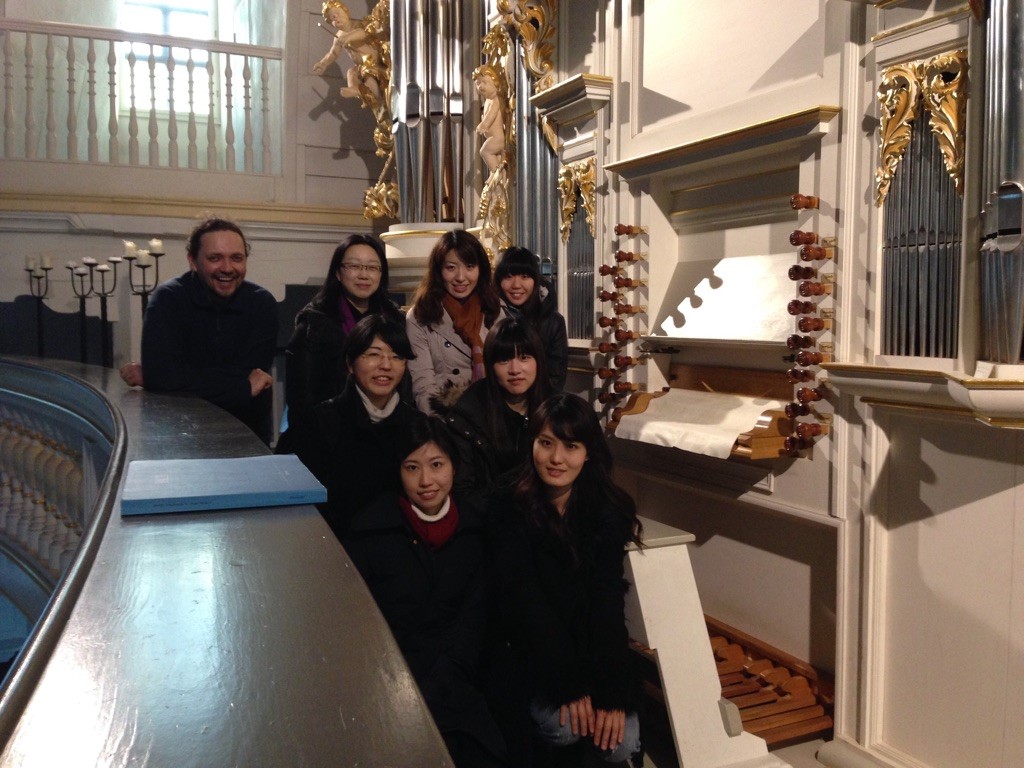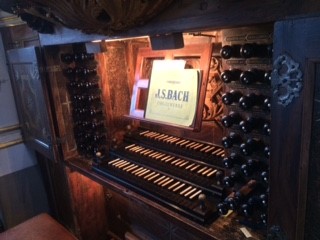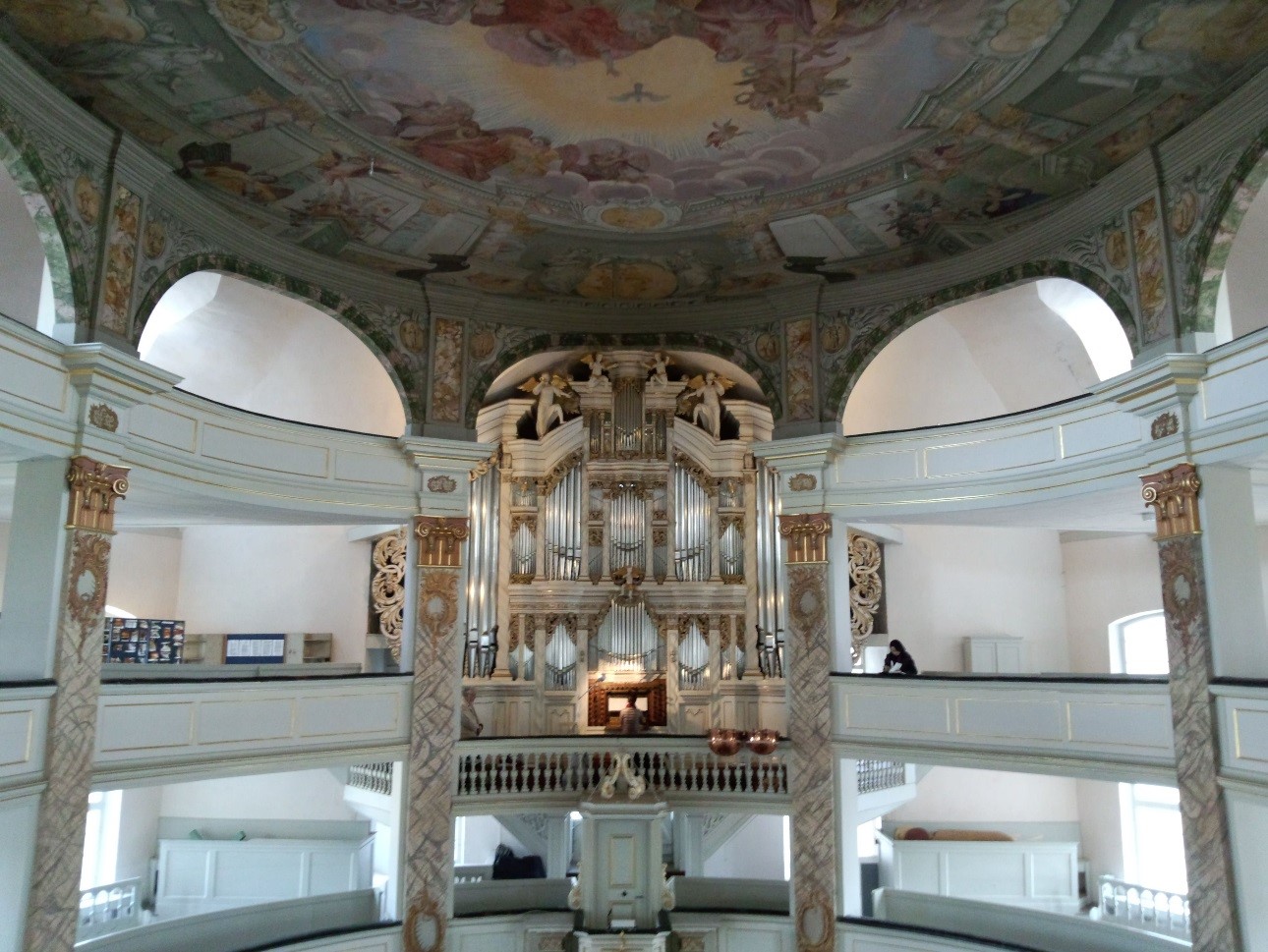J.S.バッハの触れた音を学ぶExperiencing the Sounds of J.S. Bach
July 28, 2015
基本情報
研修者:音楽学部器楽科オルガン専攻及び音楽研究科器楽専攻(オルガン)学生6名
研修先:中部ドイツ(テューリンゲン州、ザクセン州)
研修期間:2015年3月15日~3月23日
※この研修は、平成26年度藝大基金「海外派遣奨学金制度」のご支援により行われました。
海外研修の成果
今回のプロジェクトでは、オルガン科准教授・廣江理枝先生とオルガン建造家・横田宗隆さんの引率により、6名の学生が、中部ドイツのテューリンゲン州及びザクセン州を訪問しました。オルガンの最重要レパートリーの作曲家の一人であるJ.S.バッハが実際に演奏した楽器、オルガン鑑定士として鑑定した楽器、交流のあったオルガン建造家が関わった楽器など、6日間で6人の建造家(Sterzing, Wender, Trost, Volckland, Silbermann, Hildebrant)による計12のオルガンを見学しました。
テューリンゲン州で見学したSterzing, Wender, Trost, Volcklandによるオルガンは、特徴として、豊富な低音で重厚感があり、且つ輝きのある音色を持っています。中でもペダルの16フィートのVioloneのストップ(※1)はこの地方の特筆すべきものであり、通奏低音の役割に適しているように感じました。一方、ザクセン州のフライベルクにあるSilbermannのオルガンはフランス的なリード管(※2)を持ち、ストレートに音が飛んでくる力強いオルガンでした。また、ナウムブルクの教会にあるHildebrantのオルガンは、空間が広かったこともあり天上で弾いているかのようでした。
日本の教会は残響が短く音が平面的でダイレクトに聞こえますが、ドイツの教会では丸くのびやかに会堂の中に響き渡ります。各声部がはっきりと独立して立体的に聴こえ、何度も聴いたことのある曲のはずなのに、まるで初めて聞く曲のように、まったく違って聴こえます。
事前に建造家やオルガンのデータを調べ詳細を知った上で、実際に教会オルガニストによる演奏を聞いたことによって、より深く中部ドイツのオルガンの特徴を感じることができたと同時に、教会や宗教と密接な関係のあった本来のバッハのオルガン曲の在り方を再確認することができました。
また、私たちは、それぞれのオルガンで、18世紀ドイツのレジストレーション(ストップの操作による音色の選択)について残されている資料にある通りの音を実際に試すことができました。一番衝撃的だったのは、楽器の弾きにくさでした。150cmに満たない身長だと、ペダルの1オクターヴの幅に両足を開いても届かないため、中央から離れた音を弾くために体ごと移動しなければいけなかったり、椅子が高すぎるためにほとんど立っているような状態で弾かなければいけないことでした。押せば鳴ると言われる鍵盤楽器ですが、1オクターヴがこんなにも遠いということを直に体験できてよかったです。
今回の研修を通して、曲の解釈はもちろんのこと、それぞれの楽器や残響によって弾き方を変える演奏技術、また鍵盤の音域や調律法が楽器によって様々なので、楽器に合わせて弾く曲を選ばなければいけないということ、音色の選び方、楽器の構造・歴史について、本当にもっともっと色々な面から学んでいかなければいけないということを実感しました。
※用語説明
YAMAHA音楽用語辞典より引用
(1)ストップ: 同一系列の発音対の列を選択し、鍵盤によって発音可能にする装置。
(2)リード: 金属製で、それ自体の振動で一定の楽音を発する。

Trost作、テューリンゲン州ヴァルタースハウゼンにあるオルガン

テューリンゲン州アルンシュタットの
バッハがオルガニストを務めたこともあるWenderのオルガン

ザクセン州フライベルクにあるSilbermannのオルガン
奨学金制度への謝辞
オルガンを学ぶにあたり、やはり「本場の音を聴く」ということはとても重要な事です。しかし、海外へ行って、なおかつ教会のオルガンを演奏させてもらうことは簡単ではありません。日本では、大学の練習室でコツコツ練習しながら先生のレッスン、そしてCDを聴くなどしてドイツの歴史的なオルガンの音色、演奏に想いを馳せていました。そんな時、この事業に参加したのです。
実際に憧れだったオルガンを目の前にするとあまりの迫力にただただ圧倒されるばかりでしたが、一緒に学ぶ仲間とともに色々な音色を試行錯誤しながら考え、演奏していくうちに素晴らしい響きに感動し、喜びが溢れました。
7日間という短い間でしたが、自分なりに様々なことを吸収することができました。この機会を与えてくださった先生方、そして奨学金を寄付しご支援くださった方々に感謝し、これからの学びに活かしたいと思います。
Basic Information
Participant(s):6 students majoring in organ in the Department of Instrumental Music (both graduate and undergraduate students)
Location:Thuringia (Thüringen) and Saxony (Sachsen), Germany
Period:March 15, 2015 – March 23, 2015
Achievements
Under this program, we – a group of six students led by Associate Professor Rie Hiroe and Mr. Munetaka Yokota, an organ builder – visited the central German states of Thuringia and Saxony to see the organs either played or inspected by J. S. Bach, one of the composers of the world’s most important organ repertoires, or the ones made by organ builders who had personal interactions with Bach. In total, we saw 12 organs by 6 organ builders; Sterzing, Wender, Trost, Volckland, Silbermann, and Hildebrant.
The organs built by Sterzing, Wender, Trost, and Volckland, which we saw in Thuringia, can be characterized by the deep, thick, yet sparkling sounds they produce. Above all things, the 16 foot “Violone” stop in the pedal division is a noteworthy feature of the pipe organs found in this region, and it seemed very suited for playing continuo. The organ built by Silbermann in Freiberg, Saxony, had reed pipes, just like a French-style organ, through which we heard a vigorous sound. We also visited a church in Naumburg to see the organ made by Hildebrant. The church was very spacious inside with a high ceiling, and the organ sounded as if it was being played in the sky.
Japanese churches, in general, have a shorter reverberation time, causing the organs to sound more flat and direct. We felt that the organs we saw and heard in German churches produced smooth and resonant tones that reverberated throughout the hall. Each note sounded independent and thick, and the tunes that we must have heard before sounded completely different as if we heard them for the first time.
Before actually hearing the performances by the organists on site, we did some research on the organ builders and the instruments, and it helped us a lot to better understand the characteristics of the organs in Central Germany. It also helped us relearn the original purpose of the organ music written by Bach, who had strong ties with the Church and the religion.
What is more, we were given the opportunity to try out the tones as described in the documents on the 18th century registration. What struck us most was how difficult it was, physically, to play the instrument. For those who are short in height (like 150 cm, or 5 ft), it would be hard to reach an octave in the pedals, so they would have to move their body every time they wanted to hit a key far away from the center. Besides, the bench is so high that they would have to stand up most of the time while playing. It is a common saying that any keyboard instrument will produce a sound if a key is pressed. Never did we realize that an octave was that far, and it was a good experience for us to learn about it.
Through this program, we realized how important it was to not only learn interpretations of works, but also acquire versatile techniques to play notes, depending on the instrument and sound reverberation. We also learned that it was essential to decide which piece of music to play based on the kind of the instrument, as each instrument has a different range of sound and varies in tuning methods. From how to select organ stops to understanding the structure and history of the instrument, there are so much more we need to learn.

The organ by Trost in Walthershausen, ThuringiaTrost

The organ by Wender in Arnstadt, Thuringia, which was played by Bach as an organist

The organ by Silbermann in Freiberg, Saxony


